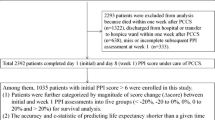Abstract
Purpose
Survival prediction is useful in selecting patients for palliative care or active anticancer therapy. The palliative and prognostic (PaP) score was shown to predict 1-month survival in terminally ill patients. Its application to patients with less advanced disease is a subject of debate. We assessed the value of the PaP score and of other clinical parameters in predicting survival in patients admitted in an oncological ward due to acute conditions. We also evaluated the frequency of active anticancer treatment in the last weeks of life.
Methods
All the 208 patients, consecutively admitted in a department of medical oncology and radiotherapy in a 9-month period, were included. Patients and disease features together with the PaP score were assessed and included in a multivariable model for survival prediction.
Results
Overall, median survival was 19 weeks and 12-week survival was 59.6%. The PaP score accurately predicted 4-week survival. Among the 39 patients who died within 4 weeks, 36% were on active treatment. The reason of admission, disease control, treatment, and PaP score were independently related to 12-week survival in the multivariate analysis; however patients with a 12-week survival lower than 30% were a minority.
Conclusions
Although the PaP score accurately predicts life expectancy, its use in the setting of acute conditions seems not straightforward, due to the overall good prognosis of these patients. Active treatment in the last period of life is common. The potential reversibility of acute conditions makes prognostic measures inadequate for the purpose of treatment choices.


Similar content being viewed by others
References
Finlay E, Casarett D (2009) Making difficult discussions easier. Using prognosis to facilitate transitions to hospice. CA Cancer J Clin 59:250–263
Stone PC, Lund S (2007) Predicting prognosis in patients with advanced cancer. Ann Oncol 18:971–976
Glare P, Virik K, Jones M et al (2003) A systematic review of physicians’ survival predictions in terminally ill cancer patients. Br Med J 327:195
Vigano A, Dorgan M, Buckingham J et al (2000) Survival prediction in terminal cancer patients: a systematic review of the medical literature. Palliat Med 14:363–374
Maltoni M, Nanni O, Pirovano M et al (1999) Successful validation of the palliative prognostic score in terminally ill cancer patients: Italian Multicenter Study Group on Palliative Care. J Pain Symptom Manage 17:240–247
Maltoni M, Caraceni A, Brunelli C et al (2005) Prognostic factors in advanced cancer patients: evidence-based clinical recommendations—a study by the steering committee of the European association for palliative care. J Clin Oncol 23:6240–6248
Glare P, Virik K (2001) Independent prospective validation of the PaP score in terminally ill patients referred to a hospital-based palliative medicine consultation service. J Pain Symptom Manage 22:891–898
Earle CC, Neville BA, Landrum MB et al (2004) Trends in the aggressiveness of cancer care near the end of life. J Clin Oncol 22:315–321
Earle CC, Landrum MB, Souza JM et al (2008) Aggressiveness of cancer care near the end of life: is it a quality of care issue? J Clin Oncol 26:2860–2866
National Hospice and Palliative Care Organization (NHPCO) Facts and figures: hospice care in America, 2009 edition. Available at http://www.nhpco.org. Accessed 20 Nov 2009
Barbot AC, Mussault P, Ingrand P, Tourani JM (2008) Assessing 2-month clinical prognosis in hospitalized patients with advanced solid tumors. J Clin Oncol 26:2538–2543
Gripp A, Moeller S, Bolke E et al (2007) Survival prediction in terminaly ill cancer patients by clinical estimates, laboratory tests, and self-rated anxiety and depression. J Clin Oncol 25:3313–3320
Glare PA, Eychmueller S, McMahon P (2004) Diagnostic accuracy of the palliative prognostic score in hospitalized patients with advanced cancer. J Clin Oncol 22:4823–4828
Tassinari D, Montanari L, Maltoni M et al (2008) The palliative prognostic score and survival in patients with advanced solid tumors receiving chemotherapy. Support Care Cancer 16:359–370
Harrington SE, Smith TJ (2008) The role of chemotherapy at the end of life. JAMA 22:2667–2678
Murillo JR, Koeller J (2006) Chemotherapy given near the end of life by community oncologists for advanced non-small cell lung cancer. Oncologist 11:1095–1099
Kao S, Shafiq J, Vardy J, Adams D (2009) Use of chemotherapy at the end of life in oncology patients. Ann Oncol 20:1555–1559
Helft PR (2005) Necessary collusion: prognostic communication with advanced cancer patients. J Clin Oncol 23:3146–3150
Francis PA (2008) Surprised by hope. J Clin Oncol 26:6001–6002
Weeks JC, Cook EF, O’Day SJ et al (1998) Relationship between cancer patients’ predictions of prognosis and their treatment preferences. JAMA 279:1709–1714
Author information
Authors and Affiliations
Corresponding author
Rights and permissions
About this article
Cite this article
Numico, G., Occelli, M., Russi, E.G. et al. Survival prediction and frequency of anticancer treatment in cancer patients hospitalized due to acute conditions. Role of clinical parameters and PaP score. Support Care Cancer 19, 1823–1830 (2011). https://doi.org/10.1007/s00520-010-1024-5
Received:
Accepted:
Published:
Issue Date:
DOI: https://doi.org/10.1007/s00520-010-1024-5




